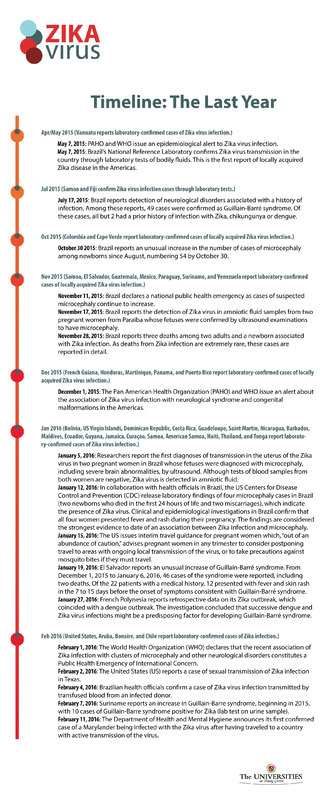Zika History Timeline: 2015-2016
Apr/May 2015 (Vanuatu reports laboratory-confirmed cases of Zika virus infection.)
May 7, 2015: PAHO and WHO issue an epidemiological alert to Zika virus infection.
May 7, 2015: Brazil’s National Reference Laboratory confirms Zika virus transmission in the country through laboratory tests of bodily fluids. This is the first report of locally acquired Zika disease in the Americas.
Jul 2015 (Samoa and Fiji confirm Zika virus infection cases through laboratory tests.)
July 17, 2015: Brazil reports detection of neurological disorders associated with a history of infection. Among these reports, 49 cases were confirmed as Guillain-Barré syndrome. Of these cases, all but 2 had a prior history of infection with Zika, chikungunya or dengue.
Oct 2015 (Colombia and Cape Verde report laboratory-confirmed cases of locally acquired Zika virus infection.)
October 30 2015: Brazil reports an unusual increase in the number of cases of microcephaly among newborns since August, numbering 54 by October 30.
Nov 2015 (Samoa, El Salvador, Guatemala, Mexico, Paraguay, Suriname, and Venezuela report laboratory-confirmed cases of locally acquired Zika virus infection.)
November 11, 2015: Brazil declares a national public health emergency as cases of suspected microcephaly continue to increase.
November 17, 2015: Brazil reports the detection of Zika virus in amniotic fluid samples from two pregnant women from Paraiba whose fetuses were confirmed by ultrasound examinations to have microcephaly.
November 28, 2015: Brazil reports three deaths among two adults and a newborn associated with Zika infection. As deaths from Zika infection are extremely rare, these cases are reported in detail.
Dec 2015 (French Guiana, Honduras, Martinique, Panama, and Puerto Rico report laboratory confirmed cases of locally acquired Zika virus infection.)
December 1, 2015: The Pan American Health Organization (PAHO) and WHO issue an alert about the association of Zika virus infection with neurological syndrome and congenital malformations in the Americas.
Jan 2016 (Bolivia, US Virgin Islands, Dominican Republic, Costa Rica, Guadeloupe, Saint Martin, Nicaragua, Barbados, Maldives, Ecuador, Guyana, Jamaica, Curaçao, Samoa, American Samoa, Haiti, Thailand, and Tonga report laboratory-confirmed cases of Zika virus infection.)
January 5, 2016: Researchers report the first diagnoses of transmission in the uterus of the Zika virus in two pregnant women in Brazil whose fetuses were diagnosed with microcephaly,including severe brain abnormalities, by ultrasound. Although tests of bloodsamples from both women are negative, Zika virus is detected in amniotic fluid.
January 12, 2016: In collaboration with health officials in Brazil, the US Centers for Disease
Control and Prevention (CDC) release laboratory findings of four microcephaly cases in Brazil
(two newborns who died in the first 24 hours of life and two miscarriages), which indicate
the presence of Zika virus. Clinical and epidemiological investigations in Brazil confirm that
all four women presented fever and rash during their pregnancy. The findings are considered
the strongest evidence to date of an association between Zika infection and microcephaly.
January 15, 2016: The US issues interim travel guidance for pregnant women which, “out of an abundance of caution,” advises pregnant women in any trimester to consider postponing travel to areas with ongoing local transmission of the virus, or to take precautions against mosquito bites if they must travel.
January 19, 2016: El Salvador reports an unusual increase of Guillain-Barré syndrome. From December 1, 2015 to January 6, 2016, 46 cases of the syndrome were reported, including two deaths. Of the 22 patients with a medical history, 12 presented with fever and skin rash in the 7 to 15 days before the onset of symptoms consistent with Guillain-Barré syndrome.
January 27, 2016: French Polynesia reports retrospective data on its Zika outbreak, which coincided with a dengue outbreak. The investigation concluded that successive dengue and Zika virus infections might be a predisposing factor for developing Guillain-Barré syndrome
Feb 2016 (United States, Aruba, Bonaire, and Chile report laboratory-confirmed cases of Zika infection.)
February 1, 2016: The World Health Organization (WHO) declares that the recent association of Zika infection with clusters of microcephaly and other neurological disorders constitutes a Public Health Emergency of International Concern.
February 2, 2016: The United States (US) reports a case of sexual transmission of Zika infection in Texas.
February 4, 2016: Brazilian health officials confirm a case of Zika virus infection transmitted by transfused blood from an infected donor.
February 7, 2016: Suriname reports an increase in Guillain-Barre syndrome, beginning in 2015, with 10 cases of Guillain-Barre syndrome positive for Zika (lab test on urine sample).
February 11, 2016: The Department of Health and Mental Hygiene announces its first confirmed case of a Marylander being infected with the Zika virus after having traveled to a country with active transmission of the virus.
